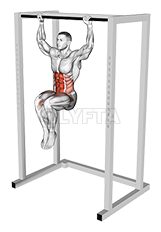
Dumbbell V-up
Exercise Profile
Related Exercises:
Introduction to the Dumbbell V-up
The Dumbbell V-up is a dynamic core exercise that combines strength training and balance to target your abdominal muscles, lower back, and obliques. It's suitable for intermediate and advanced fitness enthusiasts who are looking to intensify their core workouts. Incorporating this exercise into your routine can enhance core stability, promote better posture, and improve overall athletic performance.
Performing the: A Step-by-Step Tutorial Dumbbell V-up
- Keep your legs together and straight, and your arms fully extended holding the dumbbell.
- Simultaneously lift your legs and upper body off the ground, while bringing the dumbbell towards your feet, aiming to create a V shape with your body.
- Hold this position for a second, contracting your abdominal muscles.
- Slowly lower your legs and upper body back to the starting position, keeping the dumbbell above your head, and repeat the exercise for your desired number of repetitions.
Tips for Performing Dumbbell V-up
- **Controlled Movements**: Perform the movements slowly and under control, rather than rushing. This will help to engage the core muscles more effectively. Avoid using momentum to lift the dumbbell and your body off the ground, as this can lead to back injuries.
- **Breathing**: Breathe out as you lift your body and the dumbbell, and breathe in as you lower back down. Proper breathing not only helps to maintain a steady rhythm but also ensures that your muscles receive enough oxygen.
- **Weight Selection**: Select a weight that is challenging but manageable. Using a dumbbell that is too heavy can compromise your form and lead to injuries,
Dumbbell V-up FAQs
Can beginners do the Dumbbell V-up?
Yes, beginners can do the Dumbbell V-up exercise, but it might be challenging as it requires a good amount of core strength and balance. It's recommended to start with a lighter weight or even no weight at all until you get the hang of the movement. Always ensure to maintain proper form to avoid any injuries. If you find it too difficult, there are simpler core exercises like the regular V-up or crunches that can help you build up your core strength before attempting the Dumbbell V-up.
What are common variations of the Dumbbell V-up?
- Dumbbell V-up with Twist: This variation includes a twist at the top of the movement, helping to engage the obliques along with the rest of the core.
- Dumbbell V-up Press: Start with a regular V-up, but at the top of the movement, press the dumbbell towards the ceiling, engaging your shoulders and arms.
- Dumbbell V-up with Leg Lift: This variation includes a leg lift at the bottom of the movement, further engaging the lower abs.
- Dumbbell V-up with Russian Twist: After completing the V-up, stay in the up position and perform a Russian twist with the dumbbell, this will further challenge your balance and engage your obliques.
What are good complementing exercises for the Dumbbell V-up?
- The Plank exercise complements the Dumbbell V-up by strengthening the entire core, including the lower back and hip flexors, which are essential for maintaining the correct form and balance during the V-up movement.
- Leg Raises are another related exercise to the Dumbbell V-up as they primarily target the lower abdominal muscles, providing a balanced core workout when combined with V-ups which place more emphasis on the upper abs.
Related keywords for Dumbbell V-up
- Dumbbell V-up workout
- Waist exercises with dumbbell
- Dumbbell V-up for waist toning
- Strengthening waist with Dumbbell V-up
- Dumbbell exercises for waist
- V-up exercise with dumbbell
- Waist workout using dumbbell
- Dumbbell V-up for core strength
- Dumbbell V-up waist exercise
- Core exercises with dumbbell.











